Article published in the inaugural issue of the News Analytics Journal
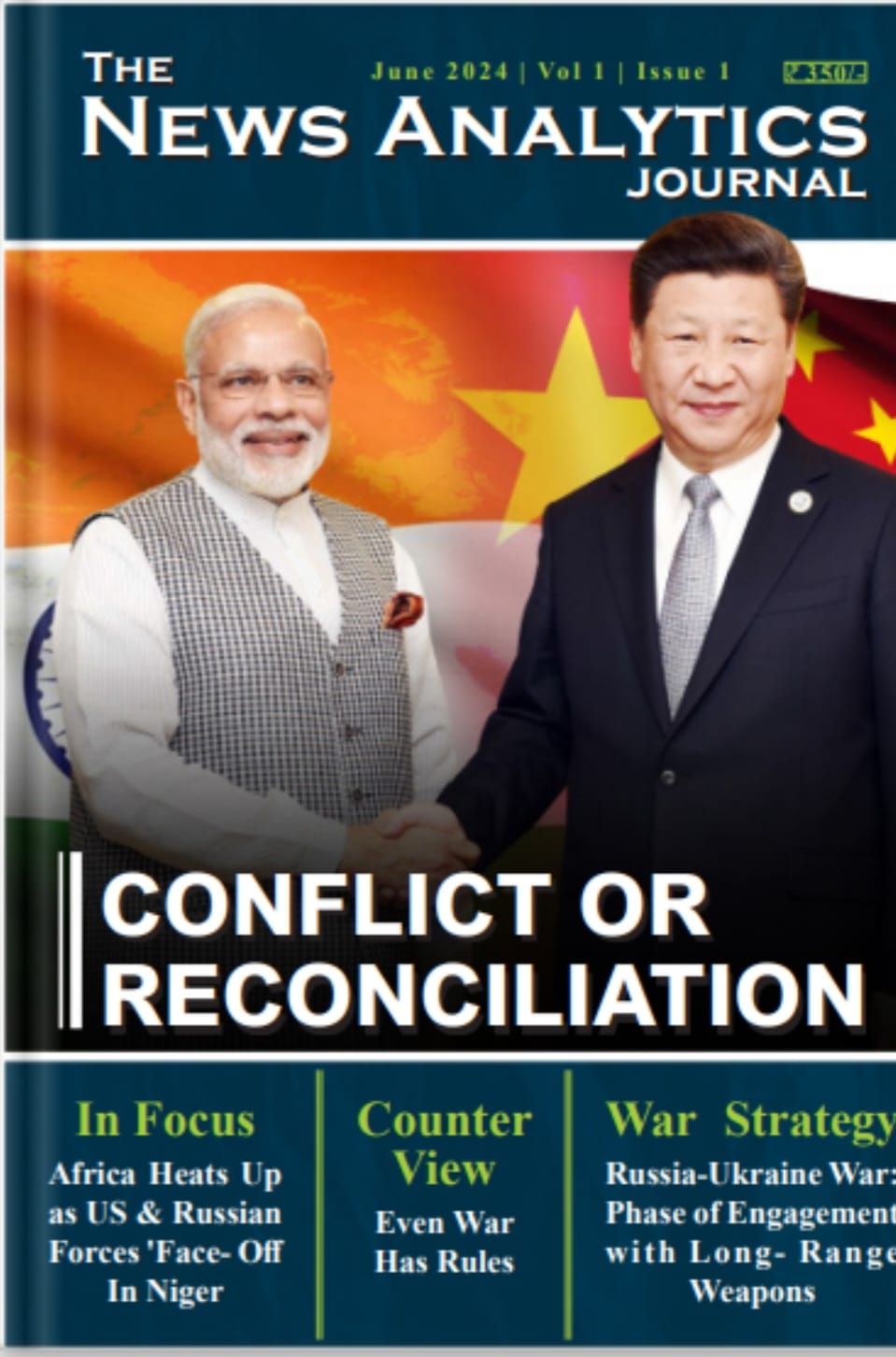
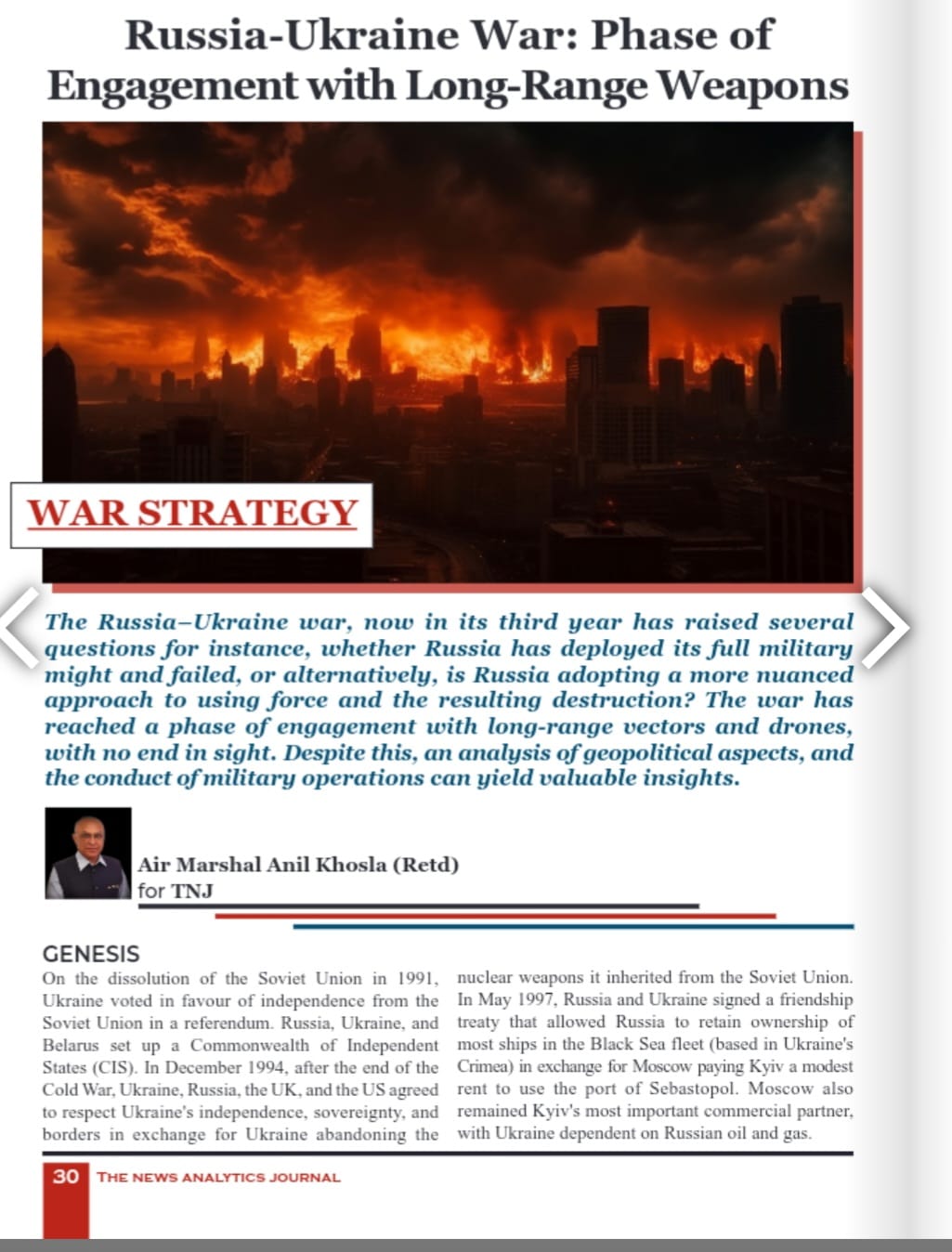
Introduction
The Russia–Ukraine war, now in its third year with no end in sight, has had a profound and complex impact on every aspect of warfare and international engagement. It has brought issues related to the new emerging world order, multilateralism, collective security, nuclear deterrence, economic sanctions, information warfare, and food and energy security to the forefront. Understanding the intricate implications of this war on international relations and military operations is of utmost importance.
Several questions are intriguing to the strategic community and military analysts. For instance, there is a debate over whether Russia has deployed its full military might and failed, as the West has criticised it for its lack of capabilities. Alternatively, is Russia adopting a more nuanced approach to using force and the resulting destruction? The war, which is still fiercely ongoing, has reached a phase of engagement with long-range vectors and drones, with Ukraine’s retaliation and Russian punitive action. There seems to be no end in sight for the conflict. Despite these debates, an analysis of geopolitical aspects, international reactions, and the conduct of military operations can yield valuable insights.
Genesis
On the dissolution of the Soviet Union in 1991, Ukraine voted in favour of independence from the Soviet Union in a referendum. Russian President Boris Yeltsin accepted the vote, and Russia, Ukraine, and Belarus set up a Commonwealth of Independent States (CIS). In December 1994, after the end of the Cold War, Ukraine, Russia, the UK, and the US agreed to respect Ukraine’s independence, sovereignty, and borders in exchange for Ukraine abandoning the nuclear weapons it inherited from the Soviet Union. In May 1997, Russia and Ukraine signed a friendship treaty. It settled a fundamental disagreement and allowed Russia to retain ownership of most ships in the Black Sea fleet (based in Ukraine’s Crimea) in exchange for Moscow paying Kyiv a modest rent to use the port of Sebastopol. Moscow also remained Kyiv’s most important commercial partner, with Ukraine dependent on Russian oil and gas.
Ukraine, perceiving the CIS as a potential tool for Moscow’s influence, maintained a cautious stance and showed an apparent inclination towards the West, actively seeking ties with the US-led NATO military alliance. This oscillation between the Eastern and Western blocs was an essential characteristic of Ukraine’s foreign policy. In 2005, Ukraine reiterated its desire to join the EU, along with NATO. In 2008, at a summit in Bucharest, NATO leaders agreed that Ukraine had a future in the alliance, sparking Moscow’s ire. In 2014, Russia sent its Special Forces to take control of strategic sites on Ukraine’s Crimea peninsula. In March 2014, Russian President Vladimir Putin signed a treaty absorbing Crimea into Russia. The annexation provoked the worst diplomatic crisis between the West and Russia since the fall of the Soviet Union. In April 2014, a pro-Russian rebellion erupted in Ukraine’s industrial eastern areas. Pro-Russian separatists in Donetsk and Lugansk declare their regions to be independent. Ukraine and its Western allies accused Russia of instigating the uprising and pouring in arms and troops to bolster the self-proclaimed republics. The clashes became a full-blown conflict in May 2014.
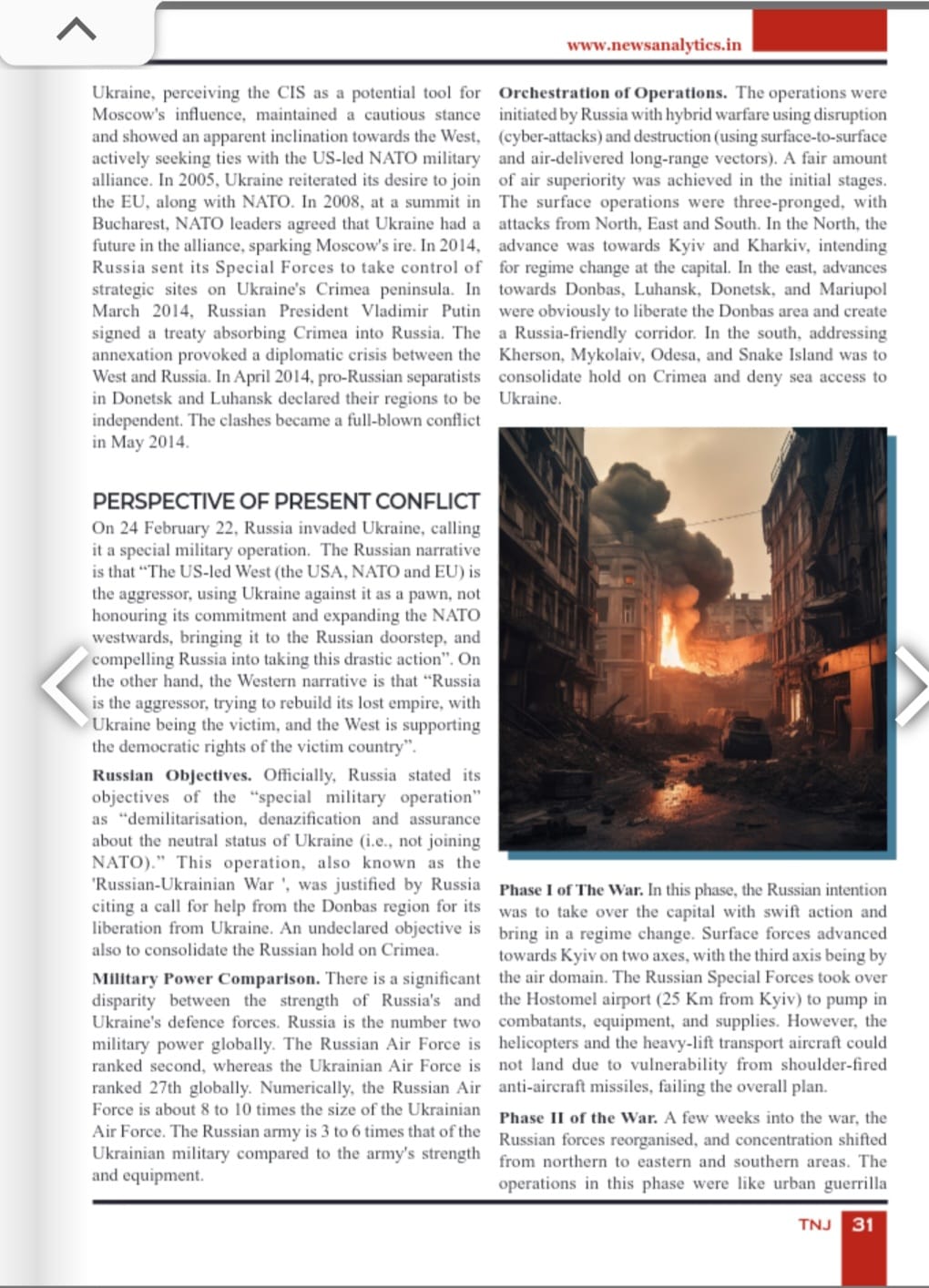
Perspective: Relevant Aspects of Present Conflict
On 24 Feb 22, Russia invaded Ukraine, calling it an extraordinary military operation. The Russian narrative is that “The US-led West (the USA, NATO and EU) is the aggressor, using Ukraine against it as a pawn, not honouring its commitment and expanding the NATO westwards, bringing it to the Russian doorstep, and compelling Russia into taking this drastic action”. On the other hand, the Western narrative is that “Russia is the aggressor, trying to rebuild its lost empire, with Ukraine being the victim, and the West is supporting the democratic rights of the victim country”.
Russian Objectives. Officially, Russia stated its objectives of the “special military operation” as “demilitarisation, denazification and assurance about the neutral status of Ukraine (i.e., not joining NATO).” This operation, also known as the ‘Russian-Ukrainian War ‘, was justified by Russia citing a call for help from the Donbas region for its liberation from Ukraine. An undeclared objective is also to consolidate the Russian hold on Crimea.
Military Power Comparison. There is a significant disparity between the strength of Russia’s and Ukraine’s defence forces. Russia is the number two military power globally. The Russian Air Force is ranked second, whereas the Ukrainian Air Force is ranked 27th globally. Numerically, the Russian Air Force is about 8 – 10 times the size of the Ukrainian Air Force. The Russian army is 3 to 6 times that of the Ukrainian military compared to the army’s strength and equipment.
Orchestration of Operations. The operations were initiated by Russia with hybrid warfare using disruption (cyber-attacks) and destruction (using surface-to-surface and air-delivered long-range vectors). A fair amount of air superiority was achieved in the initial stages. The surface operations were three-pronged, with attacks from North, East and South. In the North, the advance was towards Kyiv and Kharkiv, intending for regime change at the capital. In the east, advances towards Donbas, Luhansk, Donetsk, and Mariupol were obviously to liberate the Donbas area and create a Russia-friendly corridor. In the south, addressing Kherson, Mykolaiv, Odesa, and Snake Island was to consolidate hold on Crimea and deny sea access to Ukraine.
Phase I of The War. In this phase, the Russian intention was to take over the capital with swift action and bring in a regime change. Surface forces advanced towards Kyiv on two axes, with the third axis being by the air domain. The Russian Special Forces took over the Hostomel airport (25 Km from Kyiv) to pump in combatants, equipment and supplies. However, the helicopters and the heavy-lift transport aircraft could not land due to vulnerability from shoulder-fired anti-aircraft missiles, failing the overall plan.
Phase II of the War. The Russian forces reorganised a few weeks into the war, and concentration shifted from northern to eastern and southern areas. The operations in this phase were like urban guerrilla warfare, with Russian forces surrounding the cities and Ukrainian forces employing defensive, hit-and-run tactics. What stands out in the entire operation is that the Russians did not utilise the full potential of the airpower despite the significant disparity between the forces of the two countries.
Russian Referendum. In late September 2022, Russia held referendums in four areas of Ukraine – Donetsk, Luhansk, Kherson and Zaporizhzhia. On 30 September 2022, Russian President Vladimir Putin announced the takeover of Donetsk, Kherson, Luhansk and Zaporizhzhia in an address to both houses of the Russian parliament. As far as Russia is concerned, this marked the completion of its special operations in Ukraine.
Achievement of Objectives. So far, Russia has been able to create a ‘friendly corridor’ in its eastern region, a term used to describe the areas under Russian control that serve as a buffer zone between Russia and Ukraine. The Russians have considerably reduced the Ukrainian combat potential by destroying most of its military bases and selective defence industry. Russia has also consolidated its hold on Crimea, ending its water and power blockade. In addition, it has stalled the possibility of Ukraine joining NATO for the time being.
Application of Military Power. The Russians followed a delicate approach and did not use the full potential of their military power. The Western media criticise them for their poor planning, tactics, and training, poor performance of weapons and equipment and the lack of synergy between defence forces. One of the reasons for the self-imposed restraint could be to avoid too much destruction and collateral damage, keeping in mind the public opinion (domestic and worldwide) and long-term problems of insurgency, revolution, and resistance. For the same reason, Russia has not jumped into information warfare. The second reason could be to conserve its military power for a more significant threat in the future.
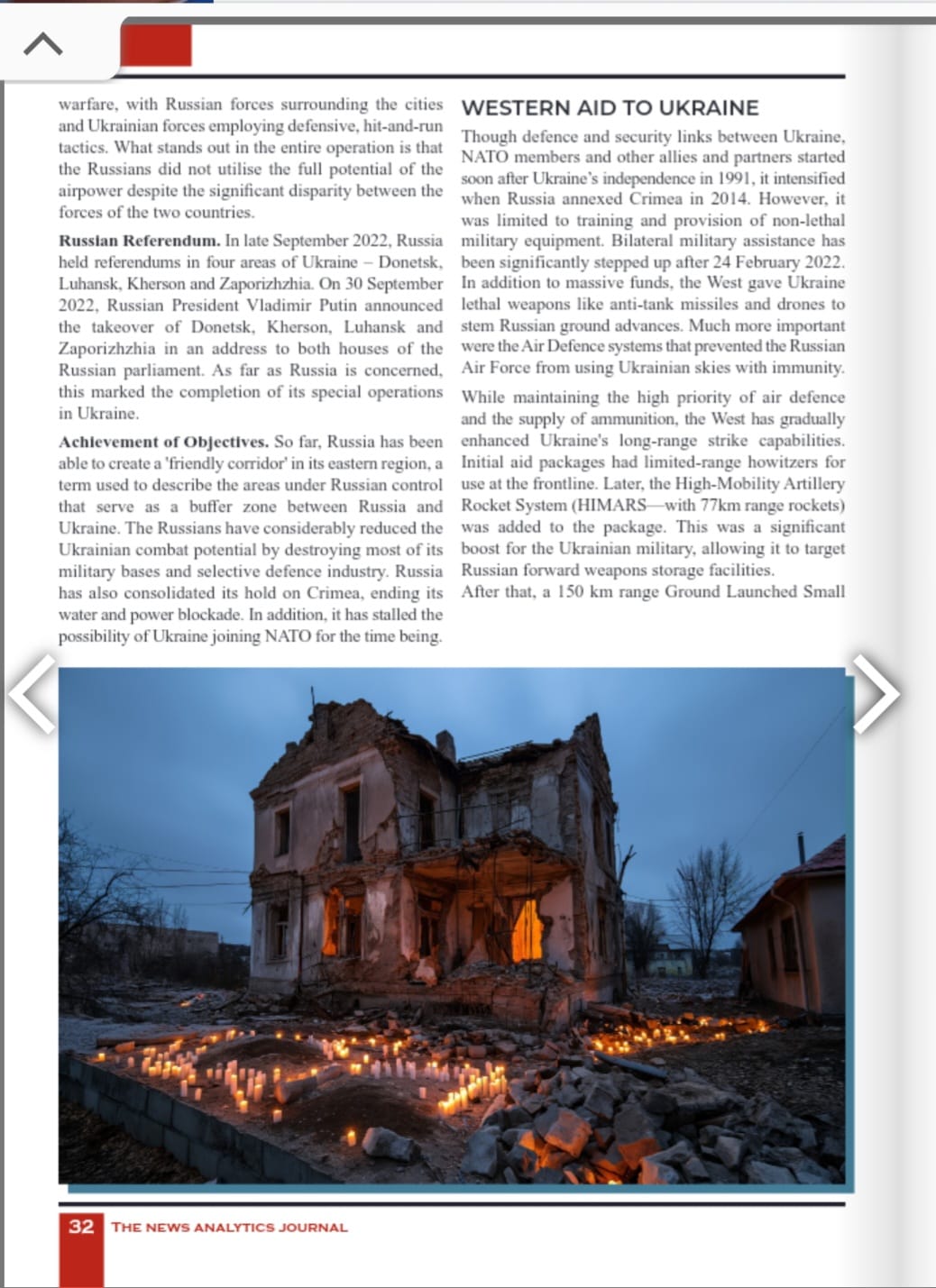
Western Aid to Ukraine: Gradually Enhancing its Offensive Capability.
Defence and security links between Ukraine, NATO members and other allies and partners started soon after Ukraine’s independence in 1991. They intensified when Russia annexed Crimea in 2014 but primarily took the form of training and the bilateral provision of non-lethal military equipment. After the commencement of the Russia-Ukraine war on 24 February 2022, bilateral military assistance has been significantly stepped up, with many allies supplying lethal weapons to Ukraine. In addition to massive funds, the West gave Ukraine equipment to defend itself. These included anti-tank missiles and drones to stem Russian ground advances. Much more important were the Air Defence systems that prevented the Russian Air Force from using Ukrainian skies with immunity.
During the initial part of the war, the U.S. and Western allies were hesitant to provide long-range offensive and more sophisticated weaponry to Ukraine over fears of an escalation of the war. Either Russia would see it as an escalation from NATO, or Ukraine itself could escalate the conflict by striking targets within Russia. As the conflict in Ukraine has evolved, so have the types of weaponry being provided.
While maintaining the high priority of air defence and the supply of ammunition, the West has gradually enhanced Ukraine’s long-range strike capabilities. Ukraine has been pleading for weapons that can strike more profoundly and deeper behind the front lines. Initial aid packages had limited-range howitzers for use at the frontline. Later, the High-Mobility Artillery Rocket System (HIMARS—with 77km range rockets) was added to the package. This was a significant boost for the Ukrainian military, allowing it to target Russian forward area ammunition dumps and weapons storage facilities. After that, a 150 km range Ground Launched Small Diameter Bomb (GLSDB) was included. It put within reach all of Russia’s supply lines in the east of the country as well as part of Russian-occupied Crimea. Late last year, the U.S. began to supply Ukraine with the older medium-range Army Tactical Missile Systems (ATACMS) armed with wide-spreading cluster munitions that can travel up to 160 Km. Now, the U.S. is leaning toward sending the longer-range version of the missile with a 300 km range.
These weapons, along with drones, provide Ukraine with the capabilities to strike deep farther inside the Russian-held territory. Kyiv has already embarked on a drone attack on oil and energy facilities inside mainland Russia and an attack on a Russian military airfield in Crimea. It also struck the province of Tatarstan earlier, marking Ukraine’s most profound attack inside Russia so far. It has also continued its attack on Russia’s fleet in the Black Sea. Russian punitive strikes with long-range missiles and hypersonic weapons follow these attacks.
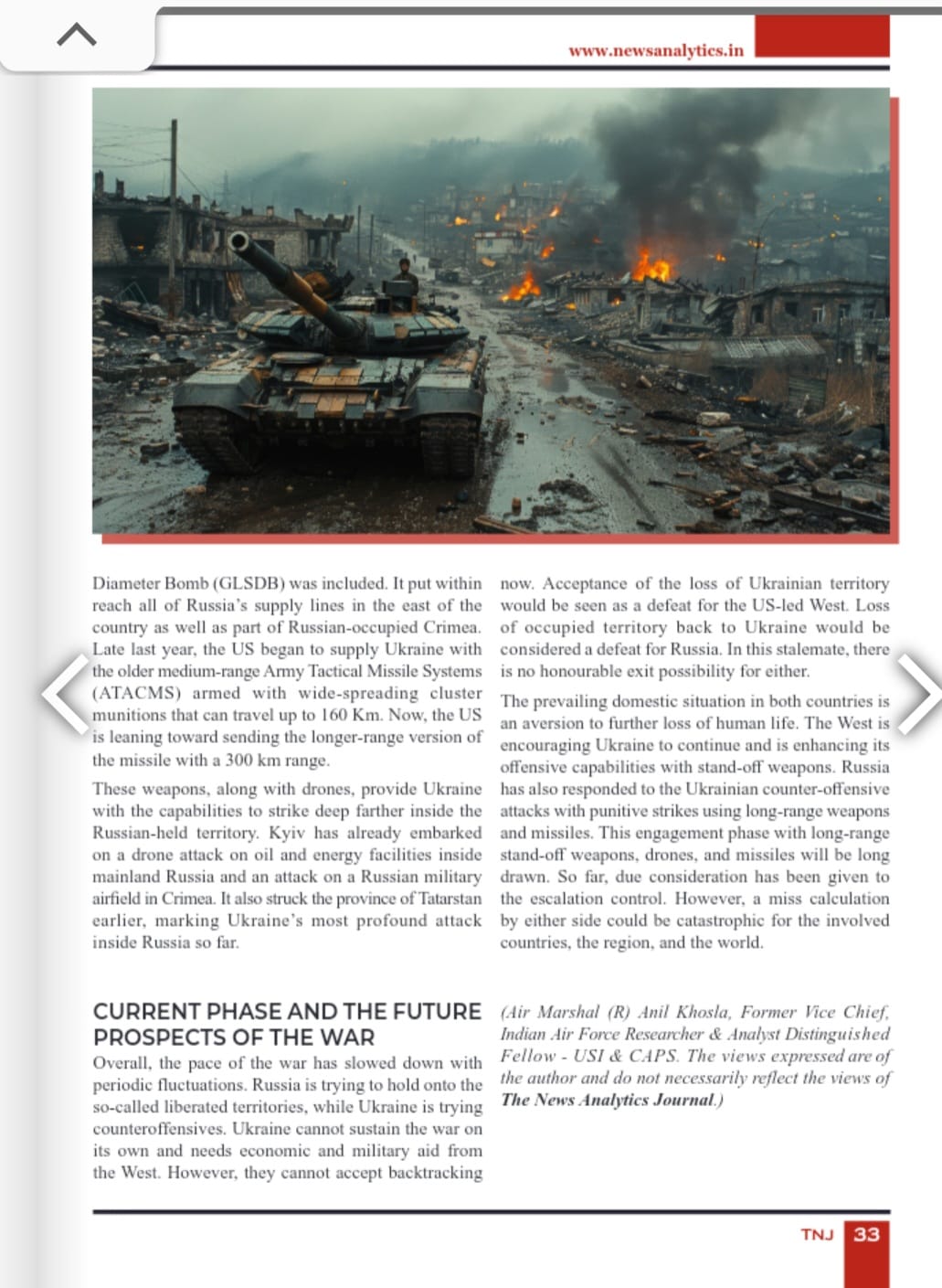
Current Phase and the Future Prospects of the War.
Overall, the pace of the war has slowed down with periodic fluctuations. Russia is trying to hold onto the so-called liberated territories, while Ukraine is trying counteroffensives. Ukraine cannot sustain the war on its own and needs economic and military aid from the West. Both countries, besides economic suffering, have suffered losses of men, materials and equipment in the two-plus-year-long war. However, they cannot accept backtracking now. Acceptance of the loss of Ukrainian territory would be seen as a defeat for the US-led West (including NATO and EU countries). Loss of occupied territory back to Ukraine would be considered a defeat for Russia. So, the stalemate continues, and there is no honourable exit possibility for either.
The prevailing domestic situation in both countries is an aversion to further loss of human life. The West is encouraging Ukraine to continue and is enhancing its offensive capabilities with stand-off weapons. Russia is responding to the Ukrainian counter-offensive attacks with punitive strikes using long-range weapons and missiles. This engagement phase with long-range stand-off weapons, drones, and missiles will be long-drawn. The war is, in the broader sense, between the Eastern and Western blocs. So far, due consideration has been given to the escalation control. However, a miss calculation by either side could be catastrophic for the involved countries, the region, and the world.
Suggestions and value additions are most welcome.
For regular updates, please register here:-
Link to the article:-
https://newsanalytics.in/russo-ukraine-war-phase-of-engagement-with-long-range-weapons/
References and credits
To all the online sites and channels.
References:-
-
- Claire Mills, “Military assistance to Ukraine since the Russian invasion”, Research Briefing, House of Commons Library, 2 May 2024.
-
- Mike Stone and Max Hunder, “Ukraine’s new weapon will force a Russian shift”, Reuters, February 2, 2023.
-
- Courtney Kube, “Biden administration is leaning toward supplying Ukraine with long-range missiles”, NBC News, Feb. 19, 2024.
-
- “Biden Administration Announces Significant New Security Assistance for Ukraine”, US Department of Defence, Press Release, April 24, 2024.
-
- Sean Boynton, “U.S. is sending Ukraine longer-range weapons with new aid why it Matters”, Global News, April 24, 2024.
-
- Brent M. Eastwood, “Why Hasn’t Russia Unleashed Its Air Power over Ukraine?” Published May 10, 2022.
-
- Tim Robinson, “Air War over Ukraine – the first days”, Royal Aeronautical Society, 2 March 2022.
-
- Davis Winkie, “Ukraine receives more armed drones amid Russian invasion”, Military Times, 04 Mar 2022.
-
- “Understanding the Russo-Ukrainian war: a guide”, from the War on the Rocks Site.
-
- Stephen Crowley, “After a ceasefire, would Russia simply fight again?” commentary, War on the Rocks, Dec 21, 2023.
Disclaimer:
Information and data included in the blog are for educational & non-commercial purposes only and have been carefully adapted, excerpted, or edited from reliable and accurate sources. All copyrighted material belongs to respective owners and is provided only for wider dissemination.
